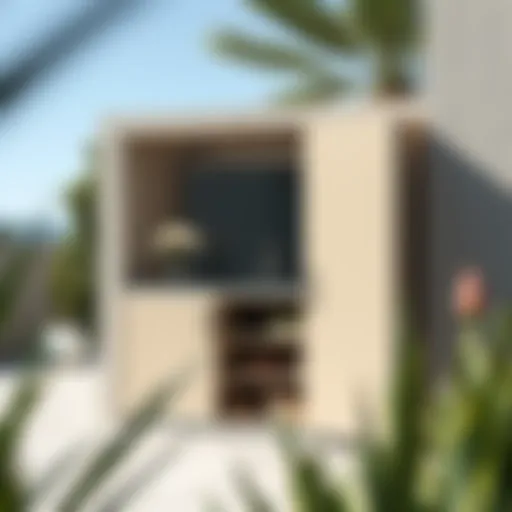Using Curtains to Define Spaces in Your Home Design
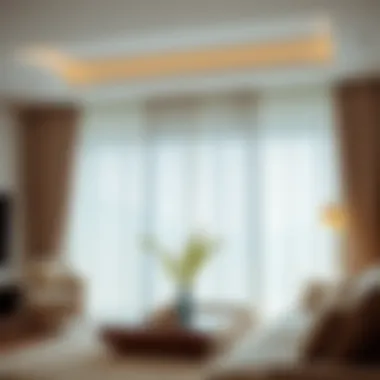

Intro
Curtains are often overlooked when it comes to styling a home. But did you know they can do a lot more than just block sunlight? When chosen thoughtfully, curtains can delineate spaces, enhance the overall aesthetic, and even provide necessary privacy. Whether you're living in a cozy apartment or a spacious family home, employing curtains strategically can improve your living experience dramatically. In this article, we'll explore the various roles curtains can play in your home design, which styles and materials work best, and how to install them effectively.
Design Inspiration
Creating distinct spaces in your home does not always require major renovations or costly remodeling. Instead, a simple addition like curtains can transform the look and feel of a room. Here, we delve into design inspiration that can elevate your interiors.
Trending Furniture Styles
Current trends promote a mix of styles for an eclectic look. With industrial, Scandinavian, and bohemian styles dominating the conversation, it’s becoming increasingly important to integrate your curtains accordingly.
- Industrial Style: Here, you might opt for sheer, lightweight materials in muted tones that fit the raw, unfinished aesthetic often associated with industrial decor.
- Scandinavian Style: Functionality is key. Heavy drapes in natural fabrics like linen can introduce warmth while still allowing for ample light penetration.
- Bohemian Style: Bold colors and patterns work well. Layering different curtains can emphasize the playful and relaxed vibe that bohemian decor is all about.
Whatever style you lean towards, consider how your curtains can complement that primary theme.
Color Palettes and Combinations
The colors you choose for your curtains can either tie a room together or create a distraction. Selecting harmonizing palettes can significantly impact how a space feels. Here’s how to think about color:
- Neutral Shades: Perfect for creating a calm atmosphere; think beige or muted whites which blend seamlessly with different palettes.
- Accent Colors: Use deeper tones like navy blue or forest green to make a bold statement and create focal points in the rooms.
- Patterns: Geometric prints or botanical designs can infuse personality and interest into your spaces. Just remember, less is usually more when balancing bold patterns with other decor.
"The right color can uplift a room and affect your mood; it’s all about finding the right hue for your unique space."
Practical Advice
Once you gather inspiration, the next step involves practical aspects of selecting and using curtains effectively.
Furniture Maintenance Tips
In conjunction with curtains, consider your furniture. Dust and light can really take a toll on both curtains and furnishings. A few vital tips to keep in mind include:
- Regularly clean curtains according to the fabric type—some can machine washed, while others require dry cleaning.
- Protect your furniture by following the recommended cleaning processes for different materials.
- Position curtains so they don’t touch the floor too much to minimize wear.
Space Planning Solutions
When using curtains to define spaces, it helps to think about general layout:
- Open Concept Homes: Use sheer curtains to separate seating areas while maintaining the flow of light.
- Private Nooks: Heavier drapes can create cozy reading corners or small offices, providing separation from the rest of your home.
- Multi-Functional Areas: Consider using curtains to divide a bedroom from a home office for an orderly, distraction-free space.
You don’t always have to stick with conventional drapery ideas. The beauty of curtains lies in their versatility—they can be installed on rods, hung from hooks, or even used with tension wires to create the perfect defined spaces.
Epilogue
Curtains can be a transformative element in home design, serving both form and function. By assessing your style preferences and understanding the functionality of different fabric choices, you can create unique and practical spaces that resonate with your personal aesthetic. Beyond mere decoration, curtains hold potential to change your home’s environment significantly. As you navigate this design pathway, remember to keep it true to your unique style and needs.
Preamble to Room Separation
In the modern home, the concept of room separation has become increasingly significant, echoing our evolving lifestyle and aesthetic preferences. As urban living spaces shrink, finding ways to carve out distinct areas within a shared environment has not only become necessary, but also a form of art. Whether you want to delineate a cozy reading nook from a bustling living space or create a serene boundary between a home office and a relaxation area, curtains emerge as an ingenious solution.
By harnessing the versatility of curtains, one gains the ability to manipulate light, color, and texture, thus crafting an environment that resonates with individual tastes while offering functionality. This simple yet impactful decor element empowers homeowners to create harmony within their spaces, catering both to the visual narrative and the practical needs of daily life.
The Concept of Space Division
At its core, space division is about establishing boundaries without the harshness of walls. Curtains serve as a flexible medium for this purpose, gently ushering in a sense of enclosure while preserving an open feel. The artistry of using curtains lies in their ability to act as dynamic barriers that can be drawn back or closed off entirely, allowing one to transition from a shared space to an intimate setting. This fluidity means that spaces can adapt to various functions throughout the day, supporting our changing needs—an ever-relevant quality to consider in contemporary interior design.
In lieu of permanent structures, curtains facilitate a softer separation. This choice fosters a layered, breathable atmosphere—think of it as having a canvas that you can paint in different strokes, blending and contrasting as you see fit. Here’s where immense potential for creativity unfolds; you might use light, airy sheers to divide a kitchen from a dining area, exuding a sense of openness, while heavier drapes might tackle noise and provide privacy between a home office and the living room.
Benefits of Using Curtains
Visual Appeal
When it comes to visual appeal, the role curtains can play is paramount—they are not just functional but can serve as a focal point in any room. Different textures, colors, and patterns can inject personality into an otherwise plain space, making the curtains themselves a canvas to showcase your style. For example, a bold pattern can add vibrancy to a muted setting, drawing the eye and sparking conversation. The fluid nature of curtains also allows you to change them seasonally without breaking the bank—something that more permanent solutions can’t offer.
Flexibility
Flexibility is another strong point for curtains. They can be easily repositioned, switched out, or layered, adapting to new trends or personal preferences without requiring any extensive remodeling. This adaptability makes curtains particularly appealing for those who enjoy changing their living space’s look. Want a brighter ambience? Switch to lighter fabrics. Need more coziness? Layer dark drapes over them. The ability to modify your space so effortlessly means it’s easy to receive guests one day and hunker down alone the next, without sacrificing comfort or aesthetics.
Cost-Effective Solution
Opting for curtains as room dividers is also a cost-effective solution compared to other methods of separation, like installing walls or permanent partitions. Curtains allow for affordable customization, as they can be sourced from a variety of retailers or even DIYed using fabric and poles from local craft stores. This not only saves you money but also brings the satisfaction of a personal touch to your decor. Yet another bonus—unlike rigid structures, curtains can be removed or updated without additional costs. Thus, they present a simple, economical strategy for redefining space while maintaining style.
Curtains—more than fabric; they create a world of your making, where spaces dance together or stand apart as you see fit.
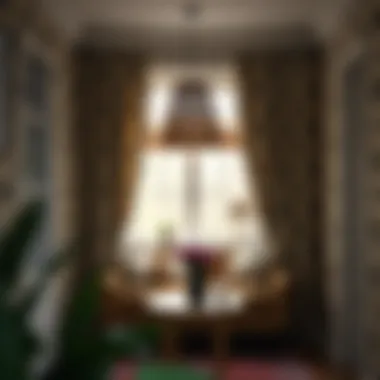

Types of Curtains for Separation
Creating distinct spaces in your home isn’t solely about furniture arrangement or paint colors; curtains play a pivotal role in establishing boundaries and enhancing the overall vibe of a room. Choosing the right type of curtain can significantly influence how separate or integrated the spaces feel. Different styles cater to varied needs, aesthetic preferences, and functional requirements. Below, we delve into specific types of curtains, shedding light on their unique benefits and how they can elevate your home environment.
Sheer Curtains
Light Filtering
Light filtering sheer curtains are often a popular choice due to their delicate nature. They allow natural light to cascade through while providing a gentle diffusion, creating a warm ambiance. This soft lighting is an effective means to enhance the mood of any room while still maintaining a sense of privacy during daylight. The key characteristic of light filtering is its ability to balance the illumination in the space, curtailing harsh sunlight without entirely blocking it out.
The unique feature of sheer curtains in this context is their versatility. Unlike heavier drapes that might create a more enclosed feel, sheer curtains promote a sense of openness. This can be especially advantageous in smaller homes or studio apartments, where maximizing light is essential. However, it’s worth noting that sheer curtains do not provide much in the way of sound dampening or true privacy once darkness falls.
Creating a Cozy Atmosphere
When it comes to creating a cozy atmosphere, sheer curtains excel by adding layers and texture to a room. They contribute soft aesthetics, making a space feel inviting and relaxing. Often paired with heavier drapes for depth, they can soften the overall appearance of your interior. Their flowing fabric works harmoniously to infuse warmth without overwhelming the decor.
This decor option is particularly advantageous for living spaces that are meant for relaxation, such as bedrooms or reading nooks. One unique feature of sheer curtains is their ability to embody various color schemes and patterns without overpowering other design elements. However, a downside is their limited functionality regarding total blackout capabilities, which might not suit all homeowners’ desires for a fully darkened room.
Heavy Drapes
Sound Absorption
If your home echoes like a concert hall, heavy drapes may come to the rescue with their excellent sound absorption qualities. The density of these fabrics actively dampens sound, making them a wise choice for media rooms or libraries where concentration is key. The key characteristic of sound absorption in heavy drapes is their mass, which acts as an effective barrier against external noise, thus creating a serene home environment.
One unique feature of heavy drapes is how they can actively improve your living quality by minimizing disturbances from outside traffic or other household activities. However, they can sometimes make a space feel heavier and more enclosed, which may not always be desirable. Thus, balancing their use with lighter elements becomes essential in maintaining an airy feel.
Privacy Enhancement
Heavy drapes are synonymous with privacy enhancement. Their ability to cover windows entirely ensures that the view from the outside remains blocked—perfect for homes situated close to the street or in densely populated areas. This addition introduces a comfort level that many homeowners seek, allowing for living spaces that feel safe and intimate.
The key characteristic of privacy enhancement through heavy drapes is their light-blocking capability. By enveloping a space in darkness, they make it easier to control light and temperature. A unique feature here is the wide variety of styles and colors available, providing endless opportunities to fit any design scheme. That said, the downside lies in the potential for a heavy look that could weigh down lighter, more modern decor trends.
Fabric Panels
Customization Options
Fabric panels are all the rage for those looking to personalize their interior spaces. The customization options available with these panels are vast, allowing homeowners to pick and choose patterns, colors, and lengths that best reflect individual tastes. This freedom of choice isn’t merely about aesthetics; it allows for practical tailor-fitting to unique window dimensions, architectural styles, and color palettes.
The key characteristic here is the ability to completely customize the fabric, often leading to one-of-a-kind designs that might become a focal point in the décor. A unique feature of fabric panels is their maneuverability; homeowners can easily alter the layout, transitioning from open to closed spaces quickly. However, the downside might be the cost implications of custom orders, which can add up compared to ready-made options.
Modern Aesthetics
Focusing on modern aesthetics, fabric panels are an elegant way to give a room a contemporary feel. With clean lines and innovative designs, they can replace traditional curtains without sacrificing style. This modern touch can transform spaces, making them feel more tailored and current compared to traditional window treatments.
The key characteristic of modern aesthetics in fabric panels lies in their minimalist approach. They often feature sleek textures and bold colors that can add visual interest without being overwhelming. This makes them a beneficial choice for those wanting a streamlined look. However, one must be cautious, as modern design can sometimes veer towards the stark—balancing it with warm elements is crucial to avoid coldness in the ambiance.
Ultimately, selecting the right type of curtains can profoundly affect the functionality and aesthetics of a home. Understanding the unique benefits of sheer curtains, heavy drapes, and fabric panels will empower homeowners to make informed decisions for enhancing their living spaces.
Design Considerations
When utilizing curtains for room separation, several design considerations arise that can significantly impact the effectiveness and visual appeal of your space. Selecting the right curtains demands an understanding of not only the functional aspects but also how they fit into the overall aesthetic of your home. The design choices include how the curtains align with various interior styles, the color choices and patterns used, and importantly, the proportions and scale within the space. Each of these elements contributes to creating an environment that feels cohesive and thoughtfully put together.
Aligning with Interior Style
Traditional Spaces
In traditional spaces, the elegance and classic feel are paramount. By incorporating rich fabrics like velvet or brocade, curtains can enrich the overall appearance, adding warmth and timelessness. A key characteristic of traditional design is the use of ornate patterns and deeper color palettes. This choice isn't just beneficial for aesthetics; it transports viewers to an era of sophistication. The unique feature here is the ability of traditional curtains to blend seamlessly with other classic furnishings, which can make an environment feel more refined. However, one should be cautious; while these curtains create grandeur, they can also make spaces feel smaller if not managed wisely.
Contemporary Themes
Contemporary themes embrace simplicity and clean lines, which can pose both challenges and opportunities for curtain design. Light fabrics, such as linen or cotton, which filter natural light, are favored for their airy feel. The key characteristic here is minimalism—every element serves a purpose, enhancing the notion of open space. This is a beneficial choice for modern living where the clutter is undesirable. The unique aspect of contemporary curtains often lies in their ability to seamlessly adapt without overwhelming the room, promoting a sense of spaciousness. However, they may not provide the warmth some seek in a homey atmosphere.
Eclectic Combinations
Eclectic combinations allow for creativity and personalization, blending various styles to create a distinctive character. Here, the specific aspect revolves around mixing patterns, textures, and colors that you might not typically consider together. A hallmark of eclectic design is the celebration of individuality. This choice can be exceptionally advantageous for those who want to express their personality. The unique feature of using curtains in this way is that they can tie different elements of a room together, creating a visual narrative. Yet, the challenge lies in finding the right balance; too many disparate elements can lead to chaos rather than harmony.
Color Palettes and Patterns
Monochromatic Schemes
Monochromatic schemes focus on different shades of a single color, creating a serene and unified look. This specific approach in curtain selection can enhance the overall calming effect of a room. The key characteristic here is simplicity; it’s all about harmony in your design choices. This choice benefits those looking to create a peaceful environment, allowing for easy integration with other colors and textures in the space. The unique feature of a monochromatic approach is its versatility, as it can adapt to various settings. On the flip side, it may lack visual interest without careful consideration of texture and material.
Bold Patterns
Bold patterns pack a punch and can transform a room. Featuring geometric designs or vivid florals, these curtains serve as statement pieces. The specific aspect of bold patterns is their ability to draw the eye, providing focal points within the space. This choice is favorable for anyone wishing to inject energy into their home. The unique feature of bold-patterned curtains lies in their capacity to ignite conversation. However, there’s a risk that they may clash with existing décor if not thoughtfully chosen.
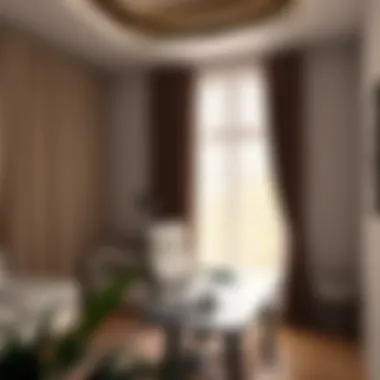

Subtle Textures
Subtle textures can add depth to a room without overwhelming the senses. These curtains might use materials like batiste or muslin, lending a delicate feel. The specific aspect here is their understated elegance; they don’t shy away but rather complement their surroundings. Beneficial for creating a sophisticated and inviting atmosphere, subtle textures can easily fit into both modern and traditional settings. Their unique feature is their ability to provide a quiet richness, although they might lack the bold impact some design goals aim for.
Proportion and Scale
Ceiling Height
When deciding on curtains, the ceiling height of a room plays a crucial role. In spaces with high ceilings, long drapes that extend almost to the floor can enhance the feel of verticality. The key characteristic here is the illusion of grandeur; tall curtains can make a space feel even more expansive. Choosing this option is beneficial as it draws the eye upward, lending a more open feel. However, in smaller rooms, long drapes might swallow the space, leading to a cramped environment.
Room Dimensions
Room dimensions dictate how curtains should be chosen. In broader rooms, larger patterns can help fill the void while smaller spaces may benefit from more subtle designs. A key characteristic is how the size of the fabric can either open up or enclose a room. This choice is beneficial when creating a sense of balance; large curtains in a small space could overwhelm it, while tiny ones in a vast room could feel lost.
Furniture Arrangement
The arrangement of furniture also impacts the selection and placement of curtains. Curtains should complement rather than compete with existing furnishings. A key aspect of thoughtful furniture arrangement is the interaction between these elements and curtains. Choosing fabric that harmonizes with furniture style, color, and scale can create a more cohesive look. This approach is beneficial, as it helps to unify the space. Conversely, a mismatch can create disjointedness, undermining overall aesthetics in your home.
Practical Installation Techniques
When it comes to using curtains to establish distinct spaces in your home, the installation methods you choose can make all the difference. Practical installation techniques are about ensuring that the curtains not only function well but also complement the interior aesthetics and durability. Properly installing curtains sets the groundwork for an effective separation of space while maximizing the utility of these home decor elements. Let’s break down the important details to consider when installing curtains for division purposes.
Choosing the Right Hardware
Rods and Tracks
Selecting the right rods and tracks is essential for achieving the desired look and functionality of your curtains. Rods are often more visible and can add to the decor by being a design element themselves. Their main characteristic is their ease of installation and the range of designs available, from sleek metal to ornate wood finishes. On the other hand, tracks offer a more streamlined look and tend to be less prominent, making them a good choice when you want the curtains to do the talking.
One unique feature of rods is their versatility – they come in various styles and can accommodate many types of curtains, whether they are light sheers or heavy drapes. However, rods can require brackets to support their weight, which might complicate installation for some homeowners.
Tracks can slide effortlessly, making them ideal for curtains that need to be drawn frequently. They are also favored in spaces like studios or open-plan areas, as they offer a clean line without the distraction of bulky hardware. The downside? They might limit your choice of curtain styles, as they usually demand specific fitting styles.
Brackets and Rings
Equally crucial to the setup are brackets and rings. Brackets support the rods and must be sturdy enough to hold the weight of the curtains, especially if you go for heavier materials. They typically come in various sizes and materials, allowing for customization in terms of aesthetics. The most significant advantage of brackets is that they can be strategically placed to enhance the appearance of the curtains – the right height and spacing can dramatically alter the way a room feels.
Then, you have rings. These can add a decorative flair while enabling smooth opening and closing of the curtains. There are different ring styles available, from simple designs to more ornamental touches that can enhance the overall look. However, a potential drawback is that they need to be installed correctly to prevent the curtains from snagging or getting misaligned.
Measuring and Cutting
Assessment of Space
Before you even think about cutting any fabric, it’s critical to assess your space accurately. The assessment of space refers to taking into consideration the layout, dimensions, and function of each area in your home. Getting this part right means ensuring that your curtains enhance, rather than impede, the flow of your space. Knowing the height of your ceilings, the width of your windows, and any structural elements that may influence how curtains will hang or be installed can save a lot of headaches later.
Utilizing a measuring tape can provide you with precise figures, allowing you to customize your curtains for a tailored fit. The importance of this stage cannot be overstated; if you get the measurement wrong, you could end up with curtains that are either too short or drag on the floor, detracting from the overall vibe.
Precision Measurements
Precision measurements go hand in hand with assessing your space. This task is about exactitude; mere estimates will not cut it. Ensuring that you measure multiple times and account for factors like the intended mounting height for curtain rods or tracks can make installation easier and more effective.
In addition to providing a better fit, precision can significantly enhance the overall functionality of your curtains. For instance, if you cut the fabric too short, it may not completely obscure the space you are trying to divide. On the flip side, if it’s too long, you may face potential tripping hazards, especially in tight quarters. So, cutting accurately based on thorough measurements is paramount.
Hanging Techniques
Rod Installation
When it comes to rod installation, you want to ensure that everything is done safely and securely. The key here is to align the rod in such a way that it enables smooth sliding and complements the overall decor. You can install the rod above the window frame or higher up to create an illusion of taller ceilings, depending on your aesthetic choice.
Using the appropriate mounting brackets to support the rod will minimize sagging over time, which is particularly important if the curtains are heavy. While rod installation might be slightly more cumbersome compared to tracks, it presents advantages like increased visibility of the curtain styles and textures.
Track Mounting
In contrast, track mounting is usually more straightforward for gaining access to your curtains. With tracks, installation can often be more forgiving, allowing for slight adjustments along their length. This feature is beneficial in accommodating varying widths of curtains, especially if you like to switch styles frequently.
Additionally, track mounting results in less visible hardware, creating a clean, uncluttered look, which is particularly appealing in modern interiors. However, this simplicity can also mean that once installed, you'll be limited in terms of how much you can change the setup later on. Consider your long-term plans for the space before making a decision.
When it comes to using curtains as a means of separation, the installation phase is where the vision truly begins to take shape.
Maintenance and Care
Taking care of curtains is as important as choosing the right ones. Regular maintenance not only preserves the look but also extends the life of your fabric. In this section, we’ll unravel the essentials of keeping your curtains in pristine condition through cleaning methods and preventive measures.
Cleaning Methods
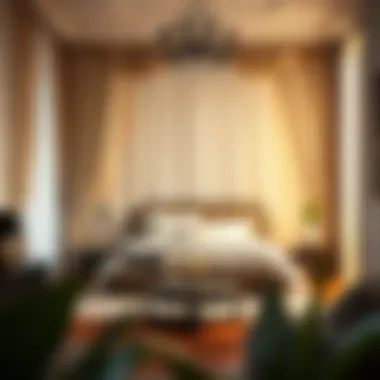
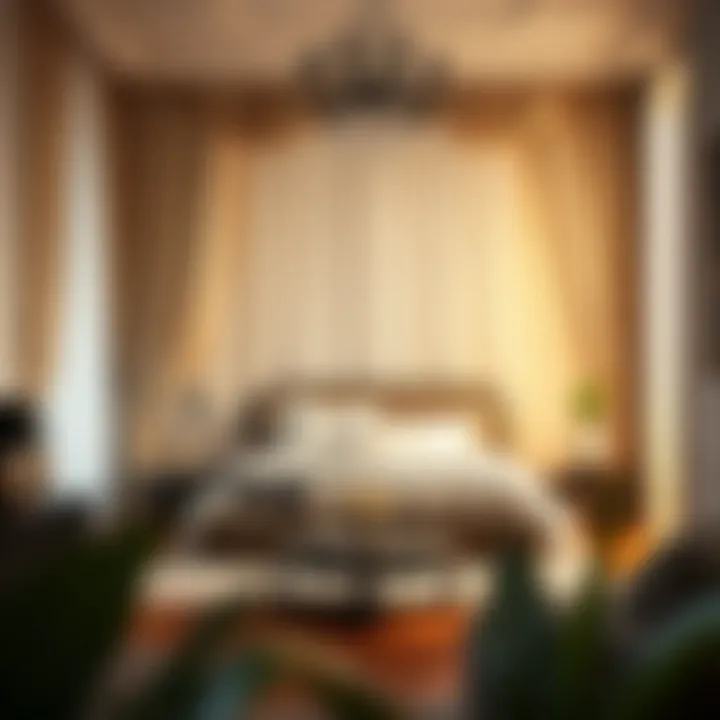
Machine Washing
Machine washing your curtains can be a straightforward way to maintain their visual appeal. This method is particularly appealing for curtains made from machine-washable materials like polyester. The key characteristic of this cleaning method is its convenience—simply toss the curtains in the washer and follow the care instructions on the label.
Using a gentle cycle and cold water can prevent fading and minimize wear, making machine washing a popular choice to quickly refresh your drapes. However, advantages include saving time and ensuring a deep clean, while a disadvantage might be that not all curtain fabrics are suitable for this treatment. Linen and silk, for instance, can shrink or get damaged with machine cycles. Always check fabric tags before diving in fully.
Spot Cleaning
Spot cleaning is a go-to method for those little accidents that happen—think spilled coffee or a child’s crayon masterpiece. This approach allows you to target specific areas without the hassle of an entire wash.
Its key characteristic lies in its precision, as you can treat stains immediately, reducing the likelihood of them setting in. This cleanliness method is a beneficial choice for more delicate fabrics. One unique feature of spot cleaning is that it preserves the overall integrity of your curtains, allowing them to maintain their shape and texture. However, a disadvantage is that it may not always fully remove tough stains, and you might find yourself doing multiple treatments, which can be a chore.
Preventive Measures
Preventive care can save homeowners a lot of trouble, sparing time on washing and repairs in the long run. The key is in understanding how environmental factors influence your fabrics.
Sun Exposure
Sun exposure is a double-edged sword. On one hand, sunlight can brighten a room; on the other, it can fade your beloved curtains over time. The key characteristic of managing sun exposure is using window films or UV-blocking liners, which are a great preventive choice. Such measures can significantly reduce fading and protect fabrics from deteriorating.
A unique feature of minimizing sun exposure is that it maintains your curtains' vibrant colors longer, thus preserving your overall interior aesthetic. The disadvantage is that blocking out light could lead to some rooms feeling a tad darker, but this can be remedied with strategic lighting choices elsewhere.
Dust Accumulation
Dust accumulation is another pesky issue. Curtains can collect a surprising amount of dust, which can affect air quality and even trigger allergies. The key characteristic of regular dusting is that it enhances the freshness of your space. Using a microfiber cloth or a vacuum with an upholstery attachment can assist in keeping dust at bay and is quite the beneficial choice.
The unique feature of controlling dust is that it not only keeps your curtains clean but also promotes a healthier living environment. However, a disadvantage is that it requires a commitment to a cleaning routine, which some may overlook amidst their busy schedules. So, if you can set a reminder or establish a habit, your curtains—and your air quality—will thank you for it.
By weaving these maintenance techniques into your routine, you ensure your curtains continue to serve their purpose for years to come. For further insights on home care, visit resources like Wikipedia or Britannica.
Case Studies of Curtains in Action
When it comes to redefining space within the home, curtains stand out not just in functionality but also in the myriad ways they can transform environments. Analyzing real-world applications of curtains in varied settings provides insights that are both practical and innovative. These case studies underscore the adaptability of curtains, shedding light on how they can elevate both aesthetics and utility in any living space.
Transforming Studio Apartments
Studio apartments pose unique challenges—limited square footage usually leaves little room for distinct sections. However, with the clever application of curtains, these small abodes can exhibit personality without compromising on space. Imagine a studio that has a main living area, a compact kitchenette, and a cozy sleeping nook. By implementing sheer curtains in a soft, muted color, the homeowner can separate their sleeping area from the rest, allowing natural light to filter through while still maintaining a feeling of space. The curtains can be drawn back during the day, making the area feel open and airy,
Benefits of this approach include:
- Visual Lightness: Sheer curtains imbue the space with brightness, preventing it from feeling too claustrophobic.
- Versatile Ambiance: The use of different fabric patterns and textures can transform the atmosphere, offering a cozy retreat at night and a spacious feel during the day.
Moreover, heavy drapes can be employed for sound absorption, resulting in a calmer environment and added privacy. For instance, a couple living in a bustling urban area used bold, dark drapes to not only darker their sleeping space but also to minimize noise from street activity. This adaptability to varied functions illustrates the power of using curtains thoughtfully.
Defining Multi-Functional Rooms
In modern homes, rooms often take on numerous roles, functioning as both entertainment spaces and personal retreats. Here, curtains become pivotal in delineating these functions seamlessly. For example, in a family room that doubles as an office, a pair of fabric panels can be hung to create a temporary wall that separates the workspace from the relaxation area. By using a lightweight fabric, one can make this division flexible; the panel can easily be drawn back when it's time for leisure.
The practical advantages are multiple:
- Dynamic Layouts: The ability to reconfigure how a space feels allows for greater adaptability based on daily activities.
- Style Cohesion: Selecting a fabric that resonates with the overall decor ensures that the decorative aspect remains intact, thus avoiding visual chaos.
- Easy Changeability: Should the need arise to reconfigure again, changing out some fabric panels can feel less daunting compared to a structural redesign.
“Curtains allow homeowners to express their unique aesthetic while providing functional solutions for space limitations.”
Other aspects that need consideration include the weight of the materials and the installation techniques adopted. Thus, in spaces where children play or pets roam, lighter fabrics may be preferable to ensure safety and ease of use.
Epilogue
Curtains have emerged as a multifaceted tool in the world of interior design, allowing homeowners to create distinct spaces that speak to both function and aesthetic appeal. In our exploration, we highlighted how curtains are not merely window dressings, but dynamic elements capable of transforming environments with ease. Here, the importance of the conclusion lies in reaffirming their practical utility and the myriad benefits they can bring to any space.
Reiterating the Practicality of Curtains
Using curtains for room separation is a practical solution that enhances the usage of space in ways beyond mere aesthetics. The flexibility they provide is unmatched. For example, consider an open-plan living area where a lightweight sheer curtain can effortlessly separate the lounge from a home office. This simple change can foster productivity while retaining a sense of openness, allowing natural light to filter through.
When discussing practicality, we must also touch on methods of installation and maintenance. A few screws, a rod, and the right choice of high-quality fabric can yield results that an expensive renovation might take years to achieve. Not only is this solution budget-friendly, but it also avoids the hassle of structural changes or permits. Furthermore, curtains are easy to clean and can be swapped out to match the season or trend, making them continuously functional. Therefore, every homeowner should consider these drapes as a worthwhile investment.
Future Trends in Curtains and Interior Separation
As we advance into a future where adaptability is essential, the role of curtains will continue to evolve. Sustainability is set to take center stage, influencing choices in materials and manufacturing processes. The emergence of eco-friendly fabrics that promote sustainability without compromising style is already gaining traction; expect to see more innovative designs that reflect environmentally conscious decisions.
Smart home technology is another frontier where curtains will find new life. Integration with systems that allow remote adjustments will offer even greater flexibility. Imagine a home where your curtains open or close automatically, responding to the time of day or the weather outside.
Looking further ahead, the blending of textiles with other materials will likely influence future designs. Consider curtains that incorporate elements of sound-absorbing materials or are treated to manage light filtration in exciting new ways. Thus, the trend will not just be about how curtains look, but how they contribute holistically to the home environment.
In summary, the potential of curtains as a tool for segmentation in spaces extends far beyond basic functionality. As we navigate evolving aesthetic sensibilities and practical needs, curtains will remain a cornerstone, adapting to the desires and demands of modern living.
"Curtains reveal the character of a home, balancing privacy with openness, and function with style."
For more information on interior design and trends, check out resources at Wikipedia, Britannica, and community discussions on platforms like Reddit.
By keeping an eye on these elements, homeowners and designers alike can craft spaces that not only look good but feel right, encapsulating the essence of their inhabitants.



